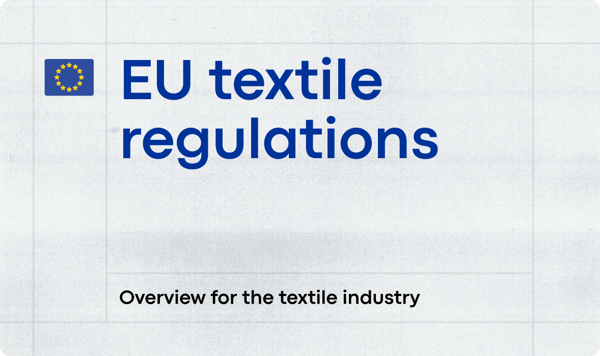Status: ✅ Approved EU law, from June 2024
In May 2024, the European Ecodesign for Sustainable Products Regulation (ESPR) was approved. The rollout of this regulation holds substantial implications for the fashion and textile industries, prompting a closer examination of how the ESPR will impact sustainability standards within our sector.
This article provides a detailed but easy-to-understand overview of the ESPR targeted for apparel and footwear companies, shedding light on the tangible effects it will have on textiles and the evolving regulatory landscape for fashion.
For an overview of all European textile regulations, such as the CSRD, visit our textile regulations hub.
TL;DR

What is the ESPR?
The Ecodesign for Sustainable Products Regulation (ESPR) expands upon the existing Ecodesign Directive. Its overarching goal is to reduce the environmental impact of products throughout their lifecycle. By emphasizing circular economy principles, the ESPR aims to encourage the creation of products that are more durable and easier to repair, reuse, and recycle. It’s expected to make a tangible impact on the fashion industry’s environmental footprint, which is responsible for 5-10% of all human-made carbon emissions.
In addition to establishing minimum "requirements for physical performance", the ESPR also introduces "information requirements" and with that the Digital Product Passport (DPP) - read more here).
We’ll get into how and when brands should comply, but first, let’s explore how the ESPR defines “eco-design.”

What is ecodesign?
Ecodesign refers to the integration of environmental considerations into a product’s design process to reduce the environmental impact of products throughout their life cycle.
For apparel and textile brands, the most notable requirements include:
- Durability: Designing products to last longer, reducing the frequency of replacements. Practically, this means apparel companies will need to assess the product's guaranteed lifetime, technical lifetime, average time between product failures, resistance to stress, and aging mechanisms.
- Reusability & Reparability: Developing a product design that allows for repeated use and includes components that can be easily repaired or replaced.
- Recycled Content: Encouraging the use of recycled materials in product manufacturing, such as recycled polyester. We expect there to be minimum requirements for the quantity of recycled content in a product.
- Possibility of Recycling: Designing products to be easily recyclable at the end of their life. Recycling textiles remains a challenge for the industry, so the ESPR aims to address this head-on. There will likely be requirements for the utilization of easily recyclable materials, safe and easy access to recyclable components, material composition and homogeneity, and the possibility for high-purity sorting.
- Presence of Substances of Concern: Avoiding or minimizing the use of hazardous or toxic materials. The European Commission will determine which substances should be considered for each of the different ecodesign requirements, such as substances that hinder recycling or re-use.
- Energy & Water Efficiency: Promoting energy and water-efficient manufacturing or other processes in the product life cycle.
- Carbon and Environmental Footprints: Assessing and reducing the overall carbon emissions and environmental impact of products.
For fashion brands, some examples of the requirements could include:
- minimum requirements for the quantity of recycled material in a garment
- requirements for the usage of easily recyclable fabrics allowing textile to textile recycling
- Assessing and reducing the environmental impact of the products by performing life cycle assessment following the PEFCR methodology
What are the ESPR reporting requirements for fashion companies?
Besides the above mentioned performance requirements the ESPR also defines information requirements to enhance transparency and sustainability in product design and manufacturing. One significant aspect of this framework is the introduction of the Digital Product Passport (DPP), which serves as a comprehensive digital record for important, product-related information and must be made accessible on the website and on the garment.
The European Commission will be establishing a dedicated web portal where all digital product passports will be registered. The data carrier present on products linking to the Digital Product Passport is still to be decided by the Commission and is expected to be known for textiles by the end of 2025.
Think of the DPP as a "digital twin" for your products. Leveraging a data carrier like a QR code, the DPP will include essential information about a product's environmental and sustainability characteristics, including details about materials used, recyclability, and repairability. Secondary legislation by the Commission will determine who may develop DPPs in the future.
You can read our complete deep dive on the Digital Product Passport requirements here.
In addition to the Digital Product Passport, the ESPR will prioritize sector-specific reporting requirements. We expect that the DPP for textiles will need to include a repairability or durability score, details on the carbon or environmental footprint, a notice on substances of concern, and instructions on disassembly, reuse, refurbishment, and recycling.
The ESPR bans the destruction of unsold footwear and textiles
The ESPR introduces a ban on the disposal of unsold consumer products, and specifically textiles, apparel, and footwear items. This is a direct move to reduce textile waste, which adds up to nearly 100 million tons per year.
Destruction is defined as damaging or discarding of a product as waste, covering the last three activities of the waste hierarchy including recycling, other recovery and disposal. However there are some important exceptions: If the product is discarded so it can be re-used, re-furbished or re-manufactured than this is not considered destruction.
Practically this means you can cut a t-shirt apart to make a new garment from it, but you cannot destroy it with the goal to recycle it (e.g. shredding to recover the fibers).
The reasoning behind this is that the EU wants to avoid that brands continue to overproduce and then just "shred" their excess inventory even if the raw materials are going to recycling. Recycling might require quite some energy consumption and/or lead to a degradation of the recovered raw materials.
Additional exemptions to destruction are available in cases of:
- Health, hygiene, and safety concerns
- Damage to products that cannot be repaired in a cost-effective manner
- Refusal of products for donation, re-use, or remanufacturing
- Destroying the product has the least negative environmental impact
- Unsellable products due to infringement of intellectual property rights, and counterfeits
- A product is deemed unfit for its intended purpose
Timeline on the obligation to disclose information on destruction
First, the ESPR introduces an obligation to disclose information and provide transparency on their website. The following infomation has to be disclosed per financial year:
- Number and weight per year
- Reasons for destruction
- Applicable waste treatment operation
- Measures taken to avoid destruction
The obligation to disclose information about the destruction is applicable to large enterprises in the first full financial year after entry into force, so in 2026/2027. For medium-sized enterprises the obligation to disclose is 2030/2031 (6 years after entry into force). Small and micro-sized enterprises (SMEs), however, are exempt from certain obligations to prevent undue burden on these smaller entities. See here the EU company size definitions.
The European Comission will still publish the detail on the format of the disclosure, which is expected in 2025.
Timeline on the prohibition on destruction
The prohibition of destroying unsold footwear and textiles is defined to start in 2026 for large enterprises and (2 years after entry into force) and in 2030 for medium-sized enterprises.
What’s the timeline for the ESPR?
The ESPR is a market-entry regulation and will apply to nearly every product that is sold on the EU market, regardless of where your brand is headquartered or the size of the company. This means also SME's are included, but can expect financial help to comply.
The ESPR proposal was approved by the European Parliament in Q2 of 2024, so it will enter into force by the end of June 2024. The ESPR itself is "framework legislation," meaning it just sets objectives but not yet concrete measures. It will still take a few years until the actual measures will be required for the fashion industry.
Negotiations continue for the ESPR Delegated Act concerning textiles, which will establish tailored market-entry requirements for the textile sector. The drafting process for the textile sector's Delegated Act is ongoing, aiming for publication by the end of 2026. Once an act is published, brands will have 18 months to prepare before the requirements enter into force. Concretely this means apparel and footwear brands have to comply to ESPR measures in in 2027/2028.
As you can see, this process is rapidly evolving. Subscribe to our Textile Regulations Hub to stay up-to-date on how the ESPR will impact your brand.
How to prepare for the ESPR as a fashion brand
Fashion and textile brands can best prepare for the implementation of the ESPR by adopting a proactive approach to eco-design. Conducting thorough assessments of your product lines can help identify areas of improvement in terms of ecodesign and assist with reporting.
Carbonfact is an environmental management platform, tailored to the needs of apparel, footwear and textile companies that enables fashion brands to perform life cycle assessments (LCA) for their products more quickly and easily, allowing them to measure and simulate their product's carbon footprint in real-time.
Carbonfact provides apparel and footwear brand with the tools they need to incorporate carbon impact into the design process from the beginning, allowing them to estimate, simulate, and incorporate carbon impact in the earliest stages of the design and sourcing processes.
See a demo video here:







![[Guide] Carbon accounting for fashion, textile, apparel, and footwear companies](https://www.carbonfact.com/hs-fs/hubfs/CA%20-%20Opt1.png?width=600&name=CA%20-%20Opt1.png)
 Angie Wu
Angie Wu

 Lidia Lüttin
Lidia Lüttin
